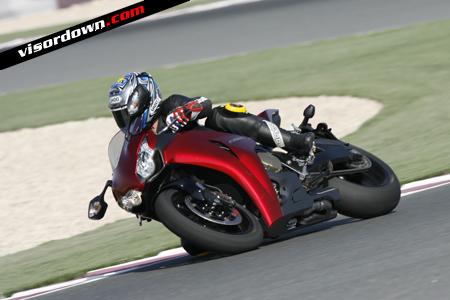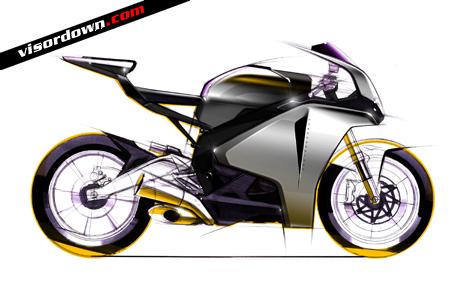2008 Honda Fireblade launch - riding impressions
Tim Skilton gives us his thoughts on Honda's new flagship


Skilton finds new Blade still sharp but forgiving
LOSAIL GP circuit is a tricky track to learn. The 3.4-mile venue, which will host the first ever nightime MotoGP race next year, consists of a kilometre-long straight, a couple of left-right flicks and 16 corners, which range from a first gear hairpin to a flat-in-fourth 130mph never-ending left hander - a bottle job in anyone's book. But even though we've come to one of the longest racetracks on the GP calendar (Losail's a full mile longer than Donington Park) Honda are keen to point out the new, ninth-generation Blade's been built with road riders in mind, rather than racetrack fanatics.
The circuit is built on featureless, pancake-flat terrain, making corner recognition difficult for anyone unfamiliar with the circuit's barren landscape. Many of Losail's corners look identical on the approach - worrying stuff when you're setting yourself up for a 100mph sweeper but get confronted by a 50mph tighty instead. Get one bend wrong and it usually buggers up the next three. Get it very wrong and it's gravel trap time - Losail doesn't suffers fools lightly, especially on a 180bhp 1000cc sportsbike.
Exiting pit lane in second, the Blade pulls hard, flicking the front wheel a foot in the air as the revs hit 8000rpm. A quick glance in the mirrors before diving onto the track shows a decent view of what's behind, rather than the shoulders and elbows stuff you get on most sportsbikes. The Honda's engine is 2.5kg lighter than the previous Blade, with refined fuel injection and lighter internals, and although the motor revs more freely than the 2007 bike the fuel injection snatches a touch when feeding in the power from a closed throttle. It's not major, just noticeable, especially when exiting slow corners.

The new Blade's quirky styling grows on you with time
Out on the back sections of Losail the Blade's able to stretch its legs, pulling close to the redline in fourth gear on some of the faster sections. The engine's smooth, refined and deceptively powerful, especially at the top end. The power surges through the rear tyre in a steady, gradual way. There are no big surprises waiting to bite you at the top end, like you get with some high-powered sportsbikes. The Blade's overall power delivery is pleasingly predictable, making fast progress easy work.
The handling's equally user-friendly: On occasions I get confused, barrelling into corners far quicker than I ought to be, tenuously feathering the front brake in the hope of scrubbing off some speed, while my buttocks clench in and ever-tightening strip-search stylee. Although the Blade doesn't sit up and head for the scenery, as many bikes do when you're trailing the front into a bend, it becomes a little less willing to turn, running wide on occasions. The problem disappeared once Honda's technicians tuned the bike's suspension during the lunch break.
Honda claim the Blade benefits from improved manoeuvrability, thanks to improved mass centralisation, or in other words, a redistribution of the bike's weighty bits. The exhaust now sits beneath the engine, rather than under the seat, which Honda claim makes changing direction at speed easier on the new Blade (they said the same thing about the underseat model, too). Honda also claim the new bike's reduced side profile also helps when changing direction, as there's less surface area to push through the air. Hard fact or PR waffle? There are a couple of sections at Losail where a firm hand's needed to get the bike to change direction quickly. The Blade went pretty much wherever I asked, feeling much more responsive than the old bike, which could be partly due to the less-intrusive steering damper, but I somehow doubt whether I'd notice it on the road at legal(ish) speeds. Honda's second-generation electronic damper helps alleviate any bar shake at high speeds - I only had one wobble on the Blade, when the front end went light exiting a corner, and it disappeared as quickly as it started. The damper's virtually unoticeable when maneouvring at low speeds.
Losail's kilometre-long straight is a great place for trying out a few testing tricks. The 180-degree right hander is perfect for finding out how much grip's available at the back end as you burst onto the main straight. There's plenty thanks to Bridgestone's new BT015 but track fans will get far more feedback from the company's super-sticky BT002, which Honda fitted to the bikes for the afternoon sessions. The main straight's long enough to briefly test high-speed wind protection, which seems fine if you drop your head a little. And, of course, there's the top speed - 286kmh on my clock, that's just shy of 179mph, your Honour. Stopping the fun at the end of the main straight are a pair of new Tokico monobloc calipers, which do the job just fine and are a noticeable improvement over the old bike's set up, lifting the rear wheel with ease. I'm not a fan of two-fingered braking, prefering the feedback from all four, but found my eager grip a little too ham-fisted for the Blade's impressive stopping power. Perhaps I'm just a little bit rusty.
The Honda's new two-piece slipper clutch is a first on the Blade. I'm no expert at the finer points of these technical gizmos, so I'll skip trying to explain how they work, but changing down to second while braking hard from 175mph+ proved no problem at all. Not sure these things are really necessary on a road bike but they're a great addition to any track machine.
Any dislikes? It sounds like predictable journo talk but the gearbox isn't as slick as the GSX-R1000. I remember reading a similar comment from a journalist about a new Honda 20 years ago, and it's surprising to see the company's gearboxes are still not quite as positive, seeming a little vague and notchy in comparison. The Honda's styling was a rather moot point at the launch venue and won't please everyone. That said, it looks better in the flesh than it does on paper. Personally, I like it and it's good to see someone having the balls to take a step away from the gaudy race replica paint schemes. But didn't Yamaha do that with the 2004 YZF-R1?

Smiles all round on the Blade at sunny Losail
So what's the verdict? Those that rode the new Kawasaki ZX-10R at the bike's press launch at Losail the previous week reckoned the Blade was more composed, less frantic and generally easier to ride. They also said the Honda wasn't as exciting, as it was probably a little too composed. I disagree. I found the Honda useable, blisteringly fast yet immensely forgiving. How forgiving? I'd not ridden a bike for 10 months before the launch (seriously, I'm not joking) but felt totally at ease on the new Honda. It gave me no frights and forgave the multitude of mistakes I threw in its face. Sure, it's possible to make the Blade misbehave but you've got to grab it by the scruff of the neck and provoke it. And that's something you can't say about most 1000cc race reps. 2008 CBR1000RR Fireblade Specs:
Engine: Liquid-cooled 4-stroke 16-valve DOHC inline-4Displacement 999.8cm³Bore x Stroke 76 x 55.1mmCompression Ratio 12.3 : 1
Max. Power Output 130.7kW / 12,000min-1 (95/1/EC)Max. Torque 113.8Nm / 8,500min-1 (95/1/EC)
Fuel System: Carburation PGM-DSFI electronic fuel injectionThrottle Bore 46mmFuel Capacity 17.7 litres (including 4-litre reserve)Ignition: Computer-controlled digital transistorisedwith electronic advance
Clutch Wet, multiplate with diaphragm springClutch Operation Mechanical; cable-actuatedTransmission 6-speed
Final Drive #530 O-ring sealed chainFrame: Type Diamond; aluminium composite twin
Dimensions 2,075 x 685 x 1,130mmWheelbase 1,405mmCaster Angle 23° 18'Trail 96.3mmTurning Radius 3.2mSeat Height 820mmGround Clearance 130mmKerb Weight 199kg (F: 105kg; R: 94kg)Max. Carrying Capacity 180kgLoaded Weight 379kg
Suspension (front)43mm inverted HMAS cartridge-typetelescopic fork with stepless preload,compression and rebound adjustment,
Suspension (rear)Unit Pro-Link with gas-charged HMAS damperfeaturing 13-step preload and steplesscompression and rebound damping adjustment
WheelsType Front Hollow-section triple-spoke cast aluminiumRear Hollow-section triple-spoke cast aluminiumRim Size Front 17M/C x MT3.50Rear 17M/C x MT6.00Tyre Size Front 120/70 ZR17M/C (58W)Rear 190/50 ZR17M/C (73W)
BrakesType Front320 x 4.5mm dual hydraulic disc with 4-pistoncalipers and sintered metal padsRear220 x 5mm hydraulic disc with single-pistoncaliper and sintered metal pads

The concept

The end product

